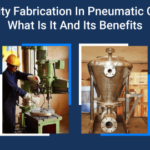In the world of industrial processing, efficient material handling is crucial for operational success. Macawber Engineering has emerged as a leader in sand conveying systems, renowned for its innovative technology and unwavering commitment to quality. This blog delves into the key factors that set Macawber apart and its impact on the sand conveying industry.
A] Expectations & Challenges in Sand Conveying
Sand conveying involves several unique challenges:
- Abrasiveness: Sand’s abrasive nature can lead to wear and tear on pneumatic conveying components. This wear depends on factors such as conveying velocity, conveying set pressure, particle size distribution, conveying distance, and moisture content.
- Particle Size Degradation: Improper conveying velocity and set pressure can result in sand particle size degradation, which can lead to the malfunctioning of the entire pneumatic conveying system—an essential concern for end users.
- Conveying Distances: The standard distances for sand conveying typically range from 30 to 70 metres. However, in some cases, the requirements can extend to 150 metres, and in extreme situations, up to 250 to 300 metres. The routing—i.e., the flow layout from the feed point to the reception point—also significantly impacts performance.
- Moisture Content: Sand generally has moisture levels up to 1% for silica or dry sand and up to 3% for river sand. Higher moisture content presents additional challenges in the conveying process.
Find efficient sand conveying solutions for your business needs. Contact Macawber today.
B] Solutions
Macawber Engineering addresses these expectations and challenges with a problem-solving approach:
- System Design Optimisation: At Macawber, complete pneumatic sand conveyor design is crucial. The focus is on vessel design, internal fluidisation, and the vessel-to-pipe size ratio for optimal plug length, flow, pressure. Operational logic is a key design factor that Macawber consistently emphasises.
- Parameter Fine-Tuning: After the system design, parameters such as velocity and flow are fine-tuned using orifices in the air manifold. Pressure adjustments are made through a regulation manifold, ensuring minimal wear and tear on components and product particles.
- Durable Components: Given the abrasive nature of sand and the vulnerability of bends in the routing, Macawber supplies bends with heavy-duty liners made from materials such as cast basalt, alumina based ceramic, and DRC (Densified Reinforced Composite). For example, cast basalt bends feature mitre-type joints with liners baked in a furnace, while alumina based ceramic bends utilise tiles of alumina-based ceramic. DRC bends incorporate a cold-rolled cement-based composite. These liners can be designed with similar hardness and thickness, ranging from 10 mm to 25 mm.
- Customised Solutions: As the leading pneumatic conveying systems manufacturer, Macawber provides tailored density stabiliser boosting solutions based on intermittent, time-based, and pressure-dependent feedback specific to the different sand conveying applications. Continuous boosting arrangements are also offered for heavy-duty, long-distance conveying. Macawber can also offer a “pipe-in-pipe” boosting solution, featuring a flute-type design with an internal air pathway for select applications subject to application.
- Moisture Management: Drying is recommended before pneumatic conveying for high moisture content or wet river sand.
C] Critical Design Features
Keeping sand’s properties in mind, Macawber incorporates customisation into vessel design:
- Fluidisation and Flow Aid: Vessel bottom fluidization, conical section flow aids, and internal purging nozzles are designed based on application requirement. Vessel dimensions are optimised to fit available headroom without compromising conveying efficiency.
- Boosting Systems: Boosting is a critical design feature that addresses the challenges of pneumatic sand conveying systems. Macawber offers tailored boosting systems, whether density stabiliser types or pipe-in-pipe arrangements, to introduce flow aids efficiently.
D] Applications and Industries
Sand is a vital natural resource used across various industries, including:
- Foundry
- Casting
- Lined pipe manufacturing
- Construction chemicals
- Ready-mix concrete
- Refractories
- Glass
- Ceramics
- Silicon chip manufacturing
- Building materials
Pneumatic Conveying Sandpumps are often the conveying system of choice for foundries with low headroom below sand feed hoppers.
Find efficient sand conveying solutions for your business needs. Contact Macawber today.
E] Products Handling Sand in These Industries
Macawber offers a range of products that effectively handle sand, including:
- Denseveyor
- Dome valves
- Diverter valves
- Bag filters
- Weigh feeders
- Jumbo bag and small bag unloading skids
- Wear-resistant bends
- Bin vent filters
In conclusion, Macawber Engineering’s innovative solutions and commitment to quality position it as the leading pneumatic sand conveyor manufacturer, addressing the unique challenges associated with this critical material. Macawber also offers dense phase pneumatic conveying systems for conveying powders, pellets, granules, and flakes.

Kedar Kamath
Kedar Kamath is a highly accomplished bulk material handling professional with 14+ years of experience at Macawber Engineering Systems India Pvt Ltd. Starting as a junior sales engineer, he progressed to his current role heading Business Development and Sales. His expertise encompasses proposals, estimations, sales, marketing, design engineering, project execution, and factory operations. Mentored by industry leaders, Kedar's technical acumen (B.Tech in Electrical Engineering, VJTI, Mumbai) and innovative approach deliver tailored solutions. He's passionate about sustainable practices and driving excellence within the industry.



